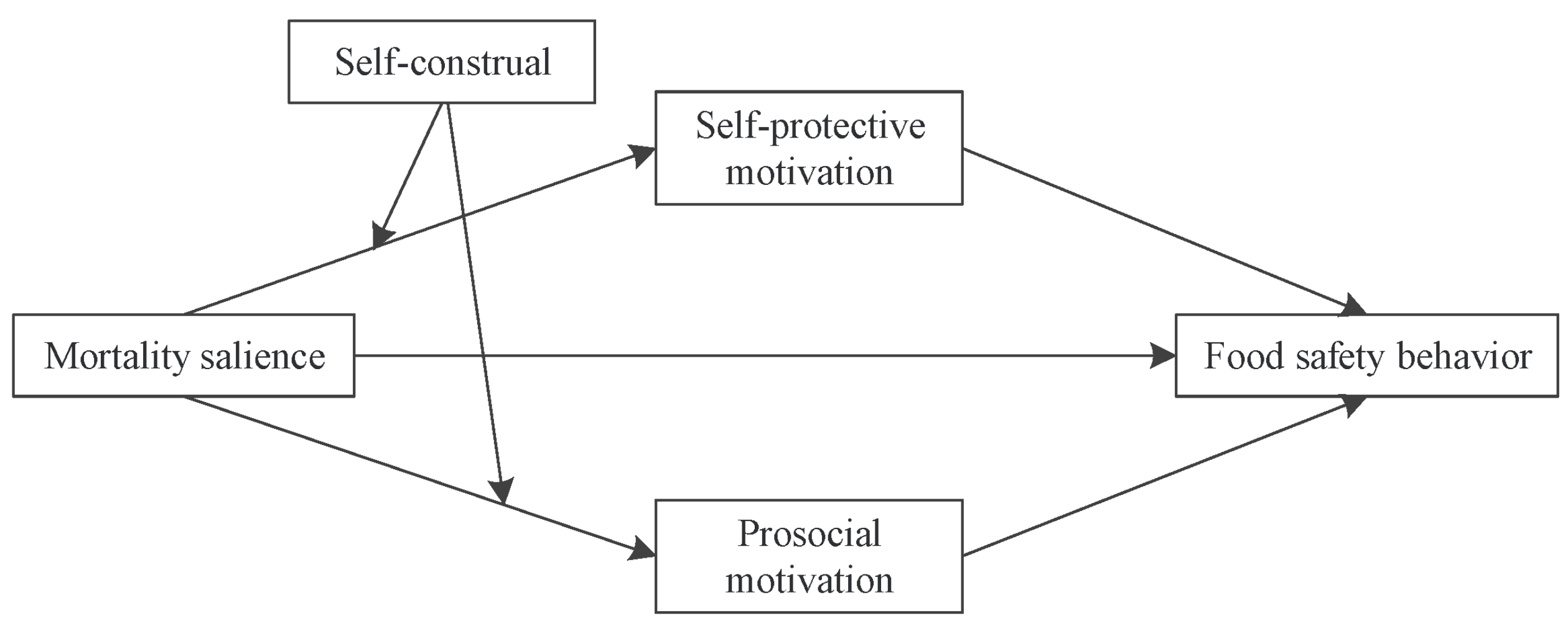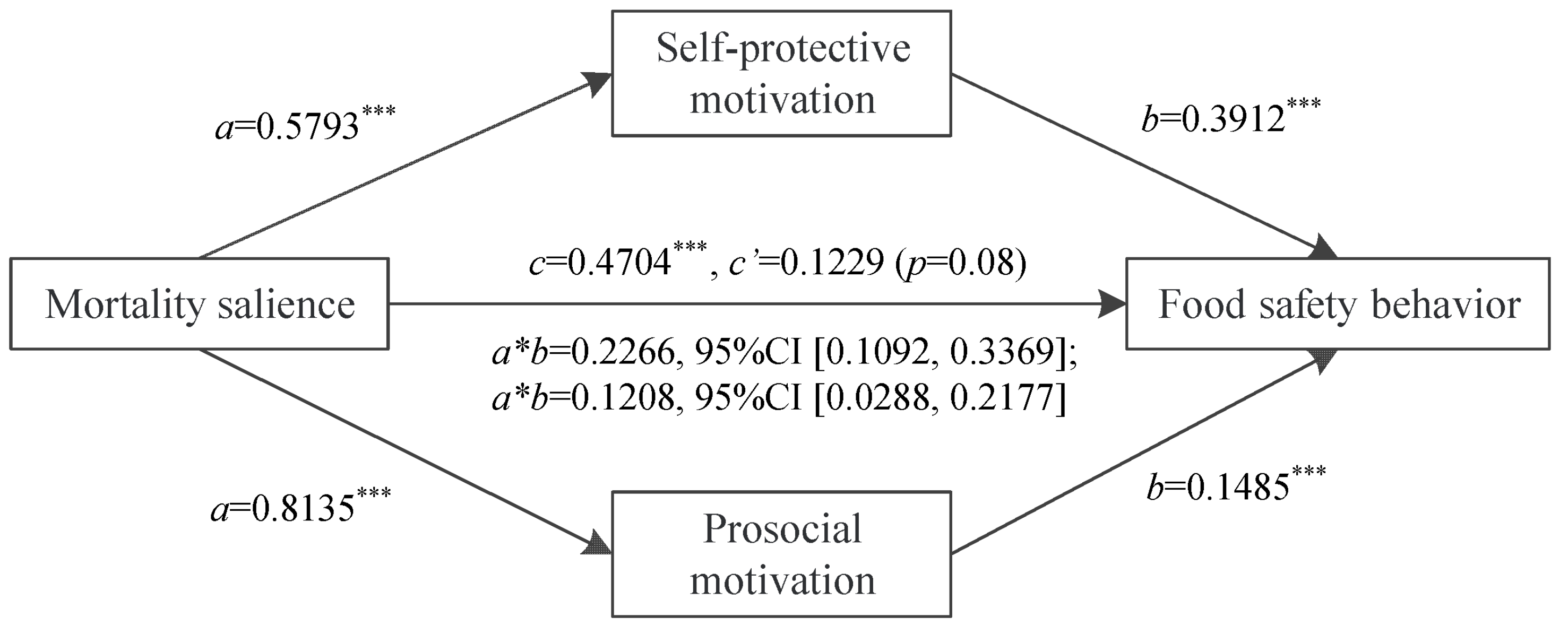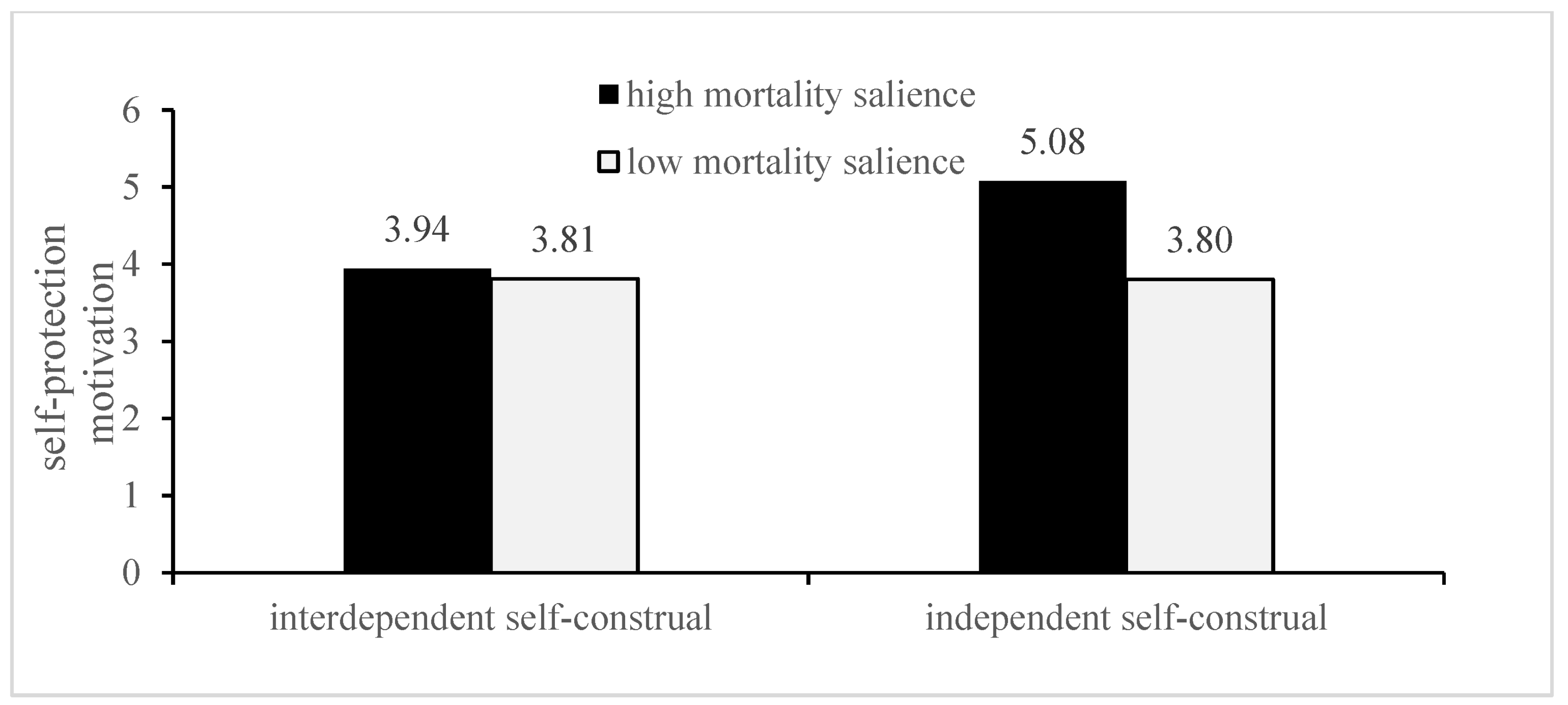Dual-Path Effect of Mortality Salience Induced by COVID-19 on Food Safety Behavior in China
Abstract
:1. Introduction
2. Literature Review and Hypothesis Development
2.1. Mortality Salience and Food Safety Behavior
2.2. Mediating Role of Self-Protective Motivation
2.3. Mediating Role of Prosocial Motivation
2.4. Moderating Role of Self-Construal
3. Materials and Methods
3.1. Study Design
3.2. Experimental Manipulation and Check
3.2.1. Mortality Salience Manipulation
3.2.2. Self-Construal Manipulation
3.2.3. Manipulation Check
3.3. Participants and Procedure
3.3.1. Participants
3.3.2. Procedure
4. Results
4.1. Study 1
4.2. Study 2
4.3. Study 3
5. Discussion
5.1. Theoretical Contributions
5.2. Practical Implications
5.3. Limitations and Future Research
6. Conclusions
Author Contributions
Funding
Institutional Review Board Statement
Informed Consent Statement
Data Availability Statement
Conflicts of Interest
Appendix A. Experimental Material of Mortality Salience
Appendix B. Experimental Material of Self-Construal
References
- Song, W.; Jin, X.; Gao, J.; Zhao, T. Will Buying Follow Others Ease Their Threat of Death? An Analysis of Consumer Data during the Period of COVID-19 in China. Int. J. Environ. Res. Public Health 2020, 17, 3215. [Google Scholar] [CrossRef] [PubMed]
- Pulliam, J.R.C.; Schalkwyk, C.V.; Govender, N.; Gottberg, A.V.; Cohen, C.; Groome, M.J.; Dushoff, J.; Mlisana, K.; Moultrie, H. Increased risk of SARS-CoV-2 reinfection associated with emergence of Omicron in South Africa. Science 2022, 376, 4947. [Google Scholar] [CrossRef] [PubMed]
- World Health Organization. Weekly Epidemiological Update on COVID-19. 12 April 2022. Available online: https://www.who.int/publications/m/item/weekly-epidemiological-update-on-covid-19---12-april-2022 (accessed on 14 April 2022).
- Cui, Y.X.; Zhou, X.; Zu, C.; Zhai, H.K.; Bai, B.R.; Xu, Y.M.; Li, D. Benevolent Creativity Buffers Anxiety Aroused by Mortality Salience: Terror Management in COVID-19 Pandemic. Front. Psychol. 2020, 11, 601027. [Google Scholar] [CrossRef]
- Fofana, N.K.; Latif, F.; Sarfraz, S.; Bilal; Bashir, M.F.; Komal, B. Fear and agony of the pandemic leading to stress and mental illness: An emerging crisis in the novel coronavirus (COVID-19) outbreak. Psychiatry Res. 2020, 291, 113230. [Google Scholar] [CrossRef]
- Thomas, M.S.; Feng, Y. Consumer risk perception and trusted sources of food safety information during the COVID-19 pandemic. Food Control 2021, 130, 108279. [Google Scholar] [CrossRef]
- Liu, Y.; Lv, X.; Tang, Z. The impact of mortality salience on quantified self behavior during the COVID-19 pandemic. Personal. Individ. Differ. 2021, 180, 110972. [Google Scholar] [CrossRef]
- Sonmez, F. The effect of COVID-19-induced mortality salience on delay discounting: A replication. J. Econ. Sci. Assoc. 2021, 7, 159–166. [Google Scholar] [CrossRef]
- Greenberg, J.; Solomon, S.; Pyszczynski, T. Terror Management Theory of Self-Esteem and Cultural Worldviews: Empirical Assessments and Conceptual Refinements. In Advances in Experimental Social Psychology; Zanna, M.P., Ed.; Academic Press: Cambridge, MA, USA, 1997; Volume 29, pp. 61–139. [Google Scholar]
- Nepomuceno, M.V.; Laroche, M. Do I Fear Death? The Effects of Mortality Salience on Anti-Consumption Lifestyles. J. Consum. Aff. 2016, 50, 124–144. [Google Scholar] [CrossRef]
- Arndt, J.; Greenberg, J.; Solomon, S.; Pyszczynski, T.; Schimel, J. Creativity and Terror Management: Evidence that Creative Activity Increases Guilt and Social Projection Following Mortality Salience; American Psychological Association: Worcester, MA, USA, 1999; pp. 19–32. [Google Scholar] [CrossRef]
- Greenberg, J.; Pyszczynski, T.; Solomon, S.; Simon, L.; Breus, M. Role of Consciousness and Accessibility of Death-Related Thoughts in Mortality Salience Effects; American Psychological Association: Worcester, MA, USA, 1994; pp. 627–637. [Google Scholar] [CrossRef]
- Nam, S.-J. An application of the risk perception attitude framework in food safety behavior. Hum. Ecol. Risk Assess. Int. J. 2019, 25, 1034–1047. [Google Scholar] [CrossRef]
- Veflen, N.; Rossvoll, E.; Langsrud, S.; Scholderer, J. Situated food safety behavior. Appetite 2020, 153, 104751. [Google Scholar] [CrossRef]
- Worsfold, D.; Griffith, C. A generic model for evaluating consumer food safety behaviour. Food Control 1995, 6, 357–363. [Google Scholar] [CrossRef]
- Chen, S.; Wei, H.; Meng, L.; Ran, Y. Believing in Karma: The Effect of Mortality Salience on Excessive Consumption. Front. Psychol. 2019, 10, 1519. [Google Scholar] [CrossRef] [PubMed] [Green Version]
- Audrin, C.; Cheval, B.; Chanal, J. Materialism moderates the impact of mortality salience on impulsive tendencies toward luxury brands. Death Stud. 2018, 42, 115–122. [Google Scholar] [CrossRef]
- Hu, S.; Zheng, X.; Zhang, N.; Zhu, J. The Impact of Mortality Salience on Intergenerational Altruism and the Perceived Importance of Sustainable Development Goals. Front. Psychol. 2018, 9, 1399. [Google Scholar] [CrossRef] [PubMed]
- Landau, M.J.; Greenberg, J. Play it safe or go for the gold? A terror management perspective on self-enhancement and self-protective motives in risky decision making. Pers Soc. Psychol. Bull. 2006, 32, 1633–1645. [Google Scholar] [CrossRef]
- Kang, J.; Moreno, F. Driving values to actions: Predictive modeling for environmentally sustainable product purchases. Sustain. Prod. Consum. 2020, 23, 224–235. [Google Scholar] [CrossRef]
- Lester, D. Self-Construal and the Fear of Death. Psychol. Rep. 2015, 117, 376–379. [Google Scholar] [CrossRef]
- Lee, S.; Goodall, C.; Egbert, N.; Chung, D. The Moderating Role of Self-construal in Culturally Reflected Fear Appeals. J. Health Commun. 2021, 26, 65–75. [Google Scholar] [CrossRef]
- Galton, N.; Hammond, N.G.; Stinchcombe, A. Personality traits and fears of death and dying predict ageism. Death Stud. 2020, 1–7. [Google Scholar] [CrossRef]
- Trzebiński, W.; Baran, R.; Marciniak, B. Did the COVID-19 Pandemic Make Consumers Shop Alone? The Role of Emotions and Interdependent Self-Construal. Sustainability 2021, 13, 6361. [Google Scholar] [CrossRef]
- Arndt, J.; Routledge, C.; Cox, C.R.; Goldenberg, J.L. The worm at the core: A terror management perspective on the roots of psychological dysfunction. Appl. Prev. Psychol. 2005, 11, 191–213. [Google Scholar] [CrossRef]
- Chittaro, L.; Sioni, R.; Crescentini, C.; Fabbro, F. Mortality salience in virtual reality experiences and its effects on users’ attitudes towards risk. Int. J. Hum.-Comput. Stud. 2017, 101, 10–22. [Google Scholar] [CrossRef]
- Cox, C.R.; Kersten, M. Mortality salience increases language style matching and well-being. Self Identity 2016, 15, 452–467. [Google Scholar] [CrossRef]
- Sim, K.; Chua, H.C.; Vieta, E.; Fernandez, G. The anatomy of panic buying related to the current COVID-19 pandemic. Psychiatry Res. 2020, 288, 113015. [Google Scholar] [CrossRef] [PubMed]
- Lisha, F. Public psychological characteristics and intervention strategies in emergencies: A survey during the COVID-19 epidemic. Stud. Ideol. Educ. 2020, 309, 60–65. [Google Scholar]
- Jin, S.V.; Ryu, E. “The greedy I that gives”-The paradox of egocentrism and altruism: Terror management and system justification perspectives on the interrelationship between mortality salience and charitable donations amid the COVID-19 pandemic. J. Consum. Aff. 2021, 56, 414–448. [Google Scholar] [CrossRef]
- Kim, M.J.; Hall, C.M. Do perceived risk and intervention affect crowdfunder behavior for the sustainable development goals? A model of goal-directed behavior. J. Clean. Prod. 2021, 311, 127614. [Google Scholar] [CrossRef]
- Su, F.; Song, N.; Shang, H.; Wang, J.; Xue, B. Effects of social capital, risk perception and awareness on environmental protection behavior. Ecosyst. Health Sustain. 2021, 7, 1942996. [Google Scholar] [CrossRef]
- Chen, G.; Crossland, C.; Huang, S. That Could Have Been Me: Director Deaths, CEO Mortality Salience, and Corporate Prosocial Behavior. Manag. Sci. 2020, 66, 3142–3161. [Google Scholar] [CrossRef]
- De Boeck, E.; Mortier, A.V.; Jacxsens, L.; Dequidt, L.; Vlerick, P. Towards an extended food safety culture model: Studying the moderating role of burnout and jobstress, the mediating role of food safety knowledge and motivation in the relation between food safety climate and food safety behavior. Trends Food Sci. Technol. 2017, 62, 202–214. [Google Scholar] [CrossRef]
- Mikulsen, M.; Diduck, A.P. Towards an integrated approach to disaster management and food safety governance. Int. J. Disaster Risk Reduct. 2016, 15, 116–124. [Google Scholar] [CrossRef]
- Horchner, P.M.; Brett, D.; Gormley, B.; Jenson, I.; Pointon, A.M. HACCP-based approach to the derivation of an on-farm food safety program for the Australian red meat industry. Food Control 2006, 17, 497–510. [Google Scholar] [CrossRef]
- Aruoma, O.I. The impact of food regulation on the food supply chain. Toxicology 2006, 221, 119–127. [Google Scholar] [CrossRef] [PubMed]
- Kleter, G.A.; Prandini, A.; Filippi, L.; Marvin, H.J.P. Identification of potentially emerging food safety issues by analysis of reports published by the European Community’s Rapid Alert System for Food and Feed (RASFF) during a four-year period. Food Chem. Toxicol. 2009, 47, 932–950. [Google Scholar] [CrossRef] [PubMed]
- Gizaw, Z. Public health risks related to food safety issues in the food market: A systematic literature review. Environ. Health Prev. Med. 2019, 24, 68. [Google Scholar] [CrossRef] [PubMed] [Green Version]
- Vail, K.E.; Juhl, J.; Arndt, J.; Vess, M.; Routledge, C.; Rutjens, B.T. When Death is Good for Life: Considering the Positive Trajectories of Terror Management. Personal. Soc. Psychol. Rev. 2012, 16, 303–329. [Google Scholar] [CrossRef]
- Peterson, B.E.; Stewart, A.J. Antecedents and contexts of generativity motivation at midlife. Psychol. Aging 1996, 11, 21–33. [Google Scholar] [CrossRef]
- Pyszczynski, T.; Greenberg, J.; Solomon, S.; Arndt, J.; Schimel, J. Why Do People Need Self-Esteem? A Theoretical and Empirical Review. Psychol. Bull. 2004, 130, 435–468. [Google Scholar] [CrossRef] [Green Version]
- Grant, A.M.; Wade-Benzoni, K.A. The Hot and Cool of Death Awareness at Work: Mortality Cues, Aging, and Self-Protective and Prosocial Motivations. Acad. Manag. Rev. 2009, 34, 600–622. [Google Scholar] [CrossRef] [Green Version]
- Sedikides, C. On the doggedness of self-enhancement and self-protection: How constraining are reality constraints? Self Identity 2018, 19, 251–271. [Google Scholar] [CrossRef]
- Sedikides, C. Assessment, enhancement, and verification determinants of the self-evaluation process. J. Personal. Soc. Psychol. 1993, 65, 317–338. [Google Scholar] [CrossRef]
- Alicke, M.D.; Sedikides, C. Self-enhancement and self-protection: What they are and what they do. Eur. Rev. Soc. Psychol. 2009, 20, 1–48. [Google Scholar] [CrossRef] [Green Version]
- Grant, A.M. Does intrinsic motivation fuel the prosocial fire? Motivational synergy in predicting persistence, performance, and productivity. J. Appl. Psychol. 2008, 93, 48–58. [Google Scholar] [CrossRef] [Green Version]
- Kil, H.; O’Neill, D.; Grusec, J.E. Prosocial motivation as a mediator between dispositional mindfulness and prosocial behavior. Personal. Individ. Differ. 2021, 177, 110806. [Google Scholar] [CrossRef]
- Ryan, R.M.; Deci, E.L. Intrinsic and Extrinsic Motivations: Classic Definitions and New Directions. Contemp. Educ. Psychol. 2000, 25, 54–67. [Google Scholar] [CrossRef] [PubMed]
- McAdams, D.P.; de St. Aubin, E.; Logan, R.L. Generativity among Young, Midlife, and Older Adults; American Psychological Association: Worcester, MA, USA, 1993; pp. 221–230. [Google Scholar] [CrossRef]
- Erikson, E.H. The life cycle completed: A review. In The Life Cycle Completed: A Review; W W Norton & Co.: New York, NY, USA, 1985; p. 108. [Google Scholar]
- Koole, S.L.; Greenberg, J.; Pyszczynski, T. Introducing Science to the Psychology of the Soul: Experimental Existential Psychology. Curr. Dir. Psychol. Sci. 2006, 15, 212–216. [Google Scholar] [CrossRef]
- Agag, G.; Aboul-Dahab, S.; Shehawy, Y.M.; Alamoudi, H.O.; Alharthi, M.D.; Hassan Abdelmoety, Z. Impacts of COVID-19 on the post-pandemic behaviour: The role of mortality threats and religiosity. J. Retail. Consum. Serv. 2022, 67, 102964. [Google Scholar] [CrossRef]
- Papageorge, N.W.; Zahn, M.V.; Belot, M.; van den Broek-Altenburg, E.; Choi, S.; Jamison, J.C.; Tripodi, E. Socio-demographic factors associated with self-protecting behavior during the Covid-19 pandemic. J. Popul. Econ. 2021, 34, 691–738. [Google Scholar] [CrossRef] [PubMed]
- Taniguchi, H.; Kaufman, G. Self-Construal, Social Support, and Loneliness in Japan. Appl. Res. Qual. Life 2018, 14, 941–960. [Google Scholar] [CrossRef]
- Markus, H.R.; Kitayama, S. Culture and the self: Implications for cognition, emotion, and motivation. Psychol. Rev. 1991, 98, 224–253. [Google Scholar] [CrossRef]
- Cross, S.E.; Hardin, E.E.; Gercek-Swing, B. The What, How, Why, and Where of Self-Construal. Personal. Soc. Psychol. Rev. 2010, 15, 142–179. [Google Scholar] [CrossRef] [PubMed] [Green Version]
- Song, D.; Lee, J. Balancing “We” and “I”: Self-construal and an alternative approach to seeking uniqueness. J. Consum. Behav. 2013, 12, 506–516. [Google Scholar] [CrossRef]
- Li, Y.; Wu, R.; Li, D.; Fan, H. Can scarcity of products promote or restrain consumers’ word-of-mouth in social networks? The moderating roles of products’ social visibility and consumers’ self-construal. Comput. Hum. Behav. 2019, 95, 14–23. [Google Scholar] [CrossRef]
- Lee, S.; Pounders, K.R. Intrinsic versus extrinsic goals: The role of self-construal in understanding consumer response to goal framing in social marketing. J. Bus. Res. 2019, 94, 99–112. [Google Scholar] [CrossRef]
- Wang, X.; Keh, H.T. Consumer susceptibility to cross-selling persuasion: The roles of self-construal and interpersonal harmony. J. Retail. Consum. Serv. 2017, 34, 177–184. [Google Scholar] [CrossRef]
- Kendler, K.S.; Gardner, C.O.; Prescott, C.A. Personality and the experience of environmental adversity. Psychol. Med. 2003, 33, 1193–1202. [Google Scholar] [CrossRef]
- Bruine de Bruin, W.; Carman, K.G.; Parker, A.M. Mental associations with COVID-19 and how they relate with self-reported protective behaviors: A national survey in the United States. Soc. Sci. Med. 2021, 275, 113825. [Google Scholar] [CrossRef]
- Sun, X.; Su, W.; Guo, X.; Tian, Z. The Impact of Awe Induced by COVID-19 Pandemic on Green Consumption Behavior in China. Int. J. Environ. Res. Public Health 2021, 18, 543. [Google Scholar] [CrossRef]
- Anderson, L.B. Serving public interests and enacting organizational values: An examination of public interest relations through AARP’s Tele-Town Halls. Public Relat. Rev. 2021, 47, 102109. [Google Scholar] [CrossRef]
- Simpson, B.; White, K.; Laran, J. When Public Recognition for Charitable Giving Backfires: The Role of Independent Self-Construal. J. Consum. Res. 2017, 44, 1257–1273. [Google Scholar] [CrossRef]
- White, K.; Argo, J.J. When Imitation Doesn’t Flatter: The Role of Consumer Distinctiveness in Responses to Mimicry. J. Consum. Res. 2011, 38, 667–680. [Google Scholar] [CrossRef] [Green Version]
- Ma, Z.; Yang, Z.; Mourali, M. Consumer Adoption of New Products: Independent versus Interdependent Self-Perspectives. J. Mark. 2014, 78, 101–117. [Google Scholar] [CrossRef] [Green Version]
- Aaker, J.L.; Lee, A.Y. “I” Seek Pleasures and “We” Avoid Pains: The Role of Self-Regulatory Goals in Information Processing and Persuasion. J. Consum. Res. 2001, 28, 33–49. [Google Scholar] [CrossRef] [Green Version]
- Hepper, E.G.; Gramzow, R.H.; Sedikides, C. Individual differences in self-enhancement and self-protection strategies: An integrative analysis. J. Pers 2010, 78, 781–814. [Google Scholar] [CrossRef] [PubMed] [Green Version]
- Hayes, A.F. Introduction to Mediation, Moderation, and Conditional Process Analysis: A Regression-Based Approach; Guilford Press: New York, NY, USA, 2013. [Google Scholar]
- Profeta, A.; Siddiqui, S.A.; Smetana, S.; Hossaini, S.M.; Heinz, V.; Kircher, C. The impact of Corona pandemic on consumer’s food consumption. J. Consum. Prot. Food Saf. 2021, 16, 305–314. [Google Scholar] [CrossRef]
- Chen, T.; Rong, J.; Yang, J.; Cong, G. Modeling Rumor Diffusion Process With the Consideration of Individual Heterogeneity: Take the Imported Food Safety Issue as an Example During the COVID-19 Pandemic. Front. Public Health 2022, 10, 781691. [Google Scholar] [CrossRef]
- Dogan, V. Why Do People Experience the Fear of Missing Out (FoMO)? Exposing the Link Between the Self and the FoMO Through Self-Construal. J. Cross-Cult. Psychol. 2019, 50, 524–538. [Google Scholar] [CrossRef]
- Benavides, P.; Hur, T. Self-Construal Differences in Chile and South Korea: A Brief Report. Psychol. Rep. 2020, 123, 2410–2417. [Google Scholar] [CrossRef]




| Type of Effect | Mediating Variable | Moderating Variable | Effect Size | SE | t | p | 95% CI | |
|---|---|---|---|---|---|---|---|---|
| LLCI | ULCI | |||||||
| Direct Effect | - | - | 0.313 | 0.055 | 5.75 | 0.000 | 0.2094 | 0.4290 |
| Mediation Effect | Prosocial motivation | Independent Self-construal | 0.016 | 0.023 | — | — | −0.0281 | 0.0651 |
| Interdependent Self-construal | 0.488 | 0.087 | — | — | 0.3224 | 0.6720 | ||
| Type of Effect | Mediating Variable | Moderating Variable | Effect Size | SE | t | p | 95% CI | |
|---|---|---|---|---|---|---|---|---|
| LLCI | ULCI | |||||||
| Direct Effect | - | - | 0.383 | 0.069 | 5.526 | 0.000 | 0.2458 | 0.5200 |
| Mediation Effect | Self-protection motivation | Independent Self-construal | −0.232 | 0.069 | — | — | −0.3749 | −0.1011 |
| Interdependent Self-construal | 0.008 | 0.012 | — | — | −0.1540 | 0.0329 | ||
Publisher’s Note: MDPI stays neutral with regard to jurisdictional claims in published maps and institutional affiliations. |
© 2022 by the authors. Licensee MDPI, Basel, Switzerland. This article is an open access article distributed under the terms and conditions of the Creative Commons Attribution (CC BY) license (https://creativecommons.org/licenses/by/4.0/).
Share and Cite
Ma, Y.; Guo, X.; Su, W.; Feng, Y.; Han, F. Dual-Path Effect of Mortality Salience Induced by COVID-19 on Food Safety Behavior in China. Int. J. Environ. Res. Public Health 2022, 19, 6100. https://doi.org/10.3390/ijerph19106100
Ma Y, Guo X, Su W, Feng Y, Han F. Dual-Path Effect of Mortality Salience Induced by COVID-19 on Food Safety Behavior in China. International Journal of Environmental Research and Public Health. 2022; 19(10):6100. https://doi.org/10.3390/ijerph19106100
Chicago/Turabian StyleMa, Ying, Xiaodong Guo, Weihuan Su, Yongxiang Feng, and Fang Han. 2022. "Dual-Path Effect of Mortality Salience Induced by COVID-19 on Food Safety Behavior in China" International Journal of Environmental Research and Public Health 19, no. 10: 6100. https://doi.org/10.3390/ijerph19106100
APA StyleMa, Y., Guo, X., Su, W., Feng, Y., & Han, F. (2022). Dual-Path Effect of Mortality Salience Induced by COVID-19 on Food Safety Behavior in China. International Journal of Environmental Research and Public Health, 19(10), 6100. https://doi.org/10.3390/ijerph19106100






